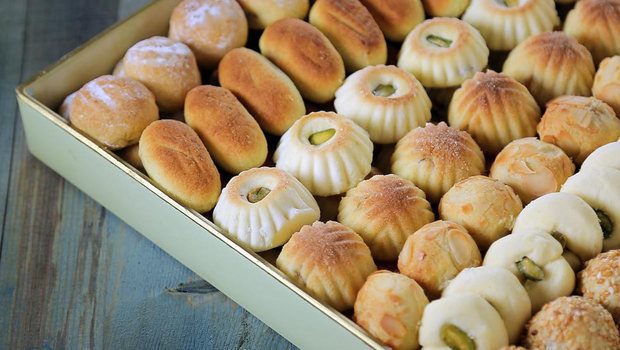As the holy fasting month of Ramadan comes to an end, Muslims around the region indulge in traditional desserts for Eid Al-Fitr.
The first day after the holy month of Ramadan has ended marks Eid Al-Fitr, one of two major celebrations in the Islamic faith.
Muslims cease from fasting during Eid Al-Fitr, which is sometimes referred to as ‘Sweet Eid’ in some cultures due to the amount and variety of sweet dishes consumed on this occasion.
During this time, families and friends gathering to celebrate the holiday over various desserts from all over the region.
Qatar

Eid mornings in Qatar wouldn’t be complete without Balaleet, a sweet breakfast meal made of vermicelli noodles, sugar, saffron and rose water and topped with eggs.
This may seem like an odd combination, but the sweet and salty combination makes for an iconic breakfast dish that’s also enjoyed in the rest of the Gulf.
Egypt
Another kind of biscuit or cookie that is popular in the region is Kahk, an essential dish for those celebrating Eid as well as other religious holidays among Muslims and Christians alike in Egypt.
Kahk is covered with powdered sugar and can be stuffed with a mixture of honey, nuts and ghee, walnuts, pistachios, or dates, or served without stuffing.
Just like Maamoul, Kahk making is also considered a social activity for women in Egypt and Sudan.
Kahk also is believed to date back as far as ancient Egyptian times. Carvings depicting people making the biscuit have been found in the ruins of ancient temples in Memphis and Thebes. It seems the ancient Egyptians loved this dessert just as much as those from the modern world do!
Palestine

The end of Ramadan in Palestine is a special occasion, and it wouldn’t be the same without Palestine’s favourite shortbread cookie Ghraybeh.
Ghraybeh is usually made with ground almonds, and like most Arabic cookies, are often small and rounded. They’re served to guests during Eid with coffee, and their light texture makes them a perfect snack during long Eid visits, which are considered tradition.
Lebanon
A Eid staple all over the region, Maamoul is a type of cookie that is widely popular in the Levant. Many in the region often make Maamoul days before Ramadan has ended to prepare for the big festivity.
The making of Maamoul, as well as other biscuits from the region, is usually a social activity where women come together to bake together.
It is made usually from semolina and is stuffed with date paste or chopped walnuts or pistachios, then finally covered with powdered sugar. The cookies can either be decorated by hand or be made using special wooden moulds.
This dessert usually disappears from the table pretty fast, and is definitely a fan favourite in Lebanon, as well as the rest of the levant.
Morocco

Moroccans usually start off their Eid celebrations with L’assida, a sweet dish also found in Tunisia. It’s a semolina based porridge dish which also includes couscous, butter, honey with seasonings.
Its served hot, so be careful when you see this North African delicacy on the table during Eid celebration!
Somalia
Over in Somalia, Xalwo is a staple for most occasions, and is almost synonymous with celebration in this East African country.
Made mainly of butter/oil and sugar, Xalwo is a delicacy that’s meant for consumption on special occasions and in small quantities, but one can’t be to blame for having one too many!
There was a time when Xalwo was eaten only during events such as weddings or Eid. Nowadays, this sweet is consumed at more frequently without need for an occasion.
Yemen

Sabaya is a multi-layered pastry desert that is served warm and topped with rich honey.
The dessert will definitely leave others coming back for more, so make sure to include this Yemeni sweet in your next Eid lunch or dinner.
Follow Doha News on Twitter, Instagram, Facebook and Youtube







